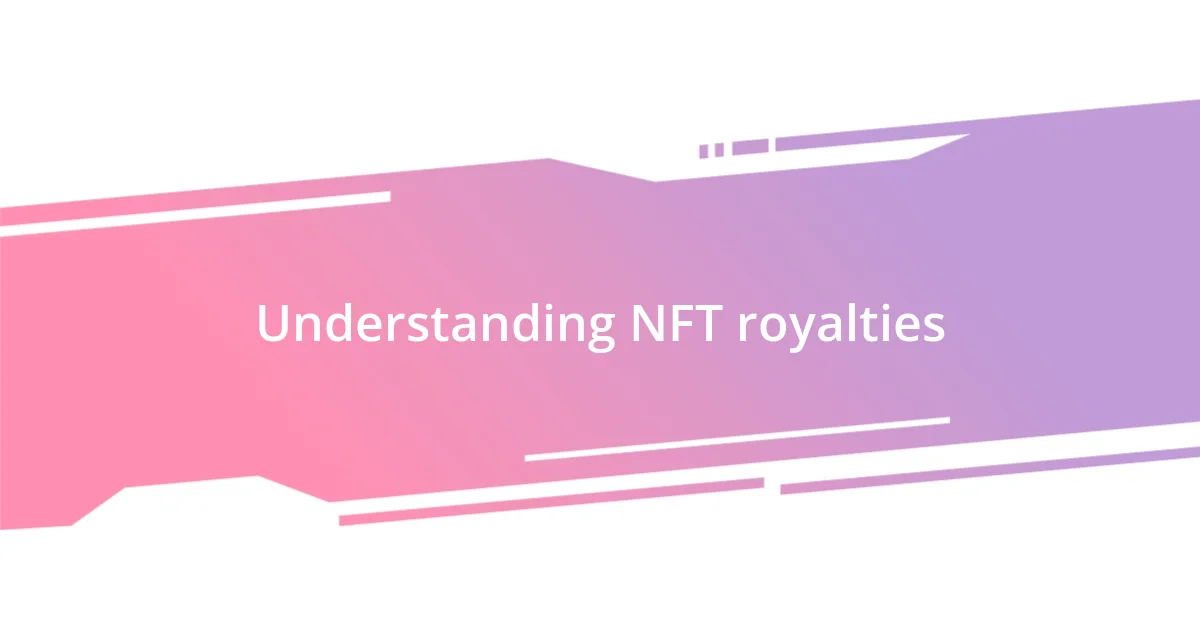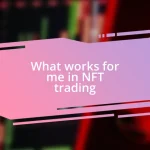Key takeaways:
- NFT royalties offer creators ongoing revenue from secondary sales, fostering a deeper connection between artists and collectors.
- Establishing appropriate royalty rates is crucial; too high risks alienation while too low diminishes earnings, highlighting the need for market understanding.
- Consistency in royalty enforcement across platforms is critical for creator trust and financial security, necessitating vigilance in choosing marketplaces.

Understanding NFT royalties
NFT royalties represent the share of profits that creators earn each time their digital asset is resold. This mechanism not only provides ongoing revenue for artists but creates a deeper connection between creators and collectors. Imagine pouring your heart into a piece of art, and every time it changes hands, you’re not just losing it; you’re receiving a little thank-you for your work.
I remember my first experience with digital art sales and royalties quite vividly. Seeing my creation resold, and checking my wallet for those royalty payments was exhilarating! It sparked a realization: NFTs can turn a one-time sale into a vibrant ongoing relationship. Have you ever wondered how it feels to know that your art continues to appreciate in value, even after it leaves your hands? It can be incredibly satisfying, reinforcing that your work is truly valued.
However, the landscape of NFT royalties is not without its pitfalls. Some marketplaces have failed to enforce royalty arrangements, leaving creators feeling frustrated and undervalued. Seeing hard work go unrewarded brings a disheartening reality. Why should artists need to fight for what they rightfully earn? Addressing these challenges is essential if we want to nurture a fair ecosystem that benefits everyone involved.

Importance of NFT royalties
NFT royalties are vital because they create a dependable revenue stream for creators, encouraging them to continue producing high-quality work. From my perspective, having a financial incentive tied to the ongoing success of their art can inspire creators to evolve and innovate continually. It’s like receiving a little pat on the back every time someone else appreciates what you’ve poured your heart into.
Here’s why NFT royalties matter:
- Sustained Income: They ensure that artists benefit from their work continuously, not just at the point of sale.
- Community Building: Royalties foster a stronger bond between creators and collectors, as both parties invest in the ongoing success of the art.
- Fair Compensation: They help combat the age-old dilemma of artist exploitation, ensuring that creators are fairly rewarded for their contributions.
I recall a conversation I had with a fellow artist who was initially skeptical about NFTs. After seeing how she could earn from secondary sales of her work, she lit up, realizing this mechanism validated her labor. It was a gamified experience; she found herself cheering for the future owners of her art. That emotional connection—knowing her work had lasting impact—was priceless!

How royalties work in NFTs
NFT royalties operate on a simple yet effective premise. When a digital asset is sold on the secondary market, a percentage of the sale price automatically goes to the original creator. This percentage can be set by the artist themselves and is enforced by most NFT marketplaces, acting like a digital safety net. I remember being amazed when I first set up my own royalty rates; it felt empowering to have that control and to know I would benefit whenever my work changed hands.
To give you a clearer picture, think of it this way: if you sell a piece for $100 with a 10% royalty, you’ll earn $10 each time it resells for the same amount in the future. This model establishes a sustainable loop of income as your work gains traction, making it akin to earning a commission each time someone enjoys the fruits of your labor. I often ponder how this creates not just financial but emotional rewards too; knowing that someone values your work enough to pass it on fuels both creativity and motivation in artists like me.
However, not all platforms enforce these royalties consistently. Some marketplaces allow buyers to bypass royalty payments, leading to a frustrating environment for creators. It reminds me of the time I noticed one of my pieces selling at a much higher price, yet I received nothing. It was disheartening! I believe it’s crucial for platforms to establish and uphold royalty agreements to ensure artists feel honored and supported, paving the way for their continued growth and sustainability.
| Royalty Structure | Impact on Creators |
|---|---|
| Flat Percentage Per Resale | Provides ongoing income and validation |
| Flexible Royalty Rates | Empowers artists to control earnings |
| Marketplace Enforcement | Ensures fair compensation |

Setting royalty rates effectively
Setting the right royalty rates is a delicate balancing act. Too high, and you risk alienating potential buyers; too low, and you diminish your ongoing earnings. Personally, I’ve found that launching my royalty rate with a thoughtful approach helped me gauge the market’s response. It’s akin to pricing a limited edition print—finding that sweet spot can sometimes mean trial and error.
When I initially set my rates, I opted for a modest 10%. I believed this would attract collectors while still rewarding me on secondary sales. Reflecting on that decision, I realized how engaging the community was; I could see artists exchanging advice about what worked for them. Isn’t it fascinating how collaboration enhances our individual journeys? It created a sense of camaraderie, reminding me that we’re all navigating the same wave of opportunity.
Now, let’s not forget the importance of understanding your audience’s purchasing behavior. Do they tend to favor higher-priced NFT art, or are they more comfortable in a lower price range? I once hosted a small auction for a piece I was passionate about, and the feedback helped refine my approach. The excitement from that live sale experience allowed me to adjust my royalties to reflect true market dynamics. What if I had set them differently? That’s the beauty of real-time data—it empowers us to iterate and adapt.

Platforms supporting NFT royalties
When it comes to platforms supporting NFT royalties, I’ve spent quite a bit of time exploring various options. OpenSea, for instance, has made headlines for their robust royalty enforcement, ensuring that creators receive their due share every time their work is sold. I fondly recall discovering this feature early in my NFT journey; it felt like finding a treasure that reinforced my decision to dive into the digital art space. Knowing that OpenSea valued my creative efforts as much as I did was incredibly validating.
Then there’s Rarible, which empowers artists with a customizable royalty feature. The flexibility resonated with me, as it mirrors my belief that artists should have the autonomy to determine how they wish to be compensated. When I first played around with different rates on Rarible, it felt like crafting a unique signature for my work. I often ask myself, how many other platforms give such power back to creators? It’s exciting and liberating to be someone who shapes their financial future through creativity.
While platforms like Foundation promise a focus on artist royalties, inconsistencies across various marketplaces can be troubling. I remember a frustrating evening when I realized one of my popular pieces was trading hands with no royalties due to loopholes on lesser-known platforms. It left me wondering, isn’t it essential for creators to feel secure in their earnings? This experience reinforced my conviction that supporting reliable platforms is key in championing the rights of artists everywhere.

Best practices for NFT creators
As NFT creators, building a brand that resonates with your audience is paramount. I remember the first time I experimented with my visual identity; I was hesitant but excited. I decided to craft a cohesive aesthetic across my NFTs. This not only made them recognizable but also fostered a community around my work. Have you ever thought about how a strong identity can influence buying decisions? It’s incredible how a well-thought-out brand can elevate your NFTs from mere digital assets to beloved collectibles.
Engagement with your community is another crucial best practice. I once took the plunge and hosted an online Q&A session with my collectors. The exchange of ideas and insights was eye-opening. Listening to their preferences and feedback helped me create future pieces that truly resonated with them. If you haven’t engaged directly with your audience, I highly recommend it; their perspectives can be invaluable in shaping your artistic journey.
Lastly, embracing the potential of collaborations can open new doors for exposure and sales. I had the opportunity to team up with a musician to create a multimedia NFT. It felt exhilarating to blend our distinct styles into something fresh. Collaborations not only expand your reach but also generate buzz within different communities. Isn’t it fascinating how two creators can come together and create something that neither could achieve alone? In my experience, the magic of collaboration can truly amplify your presence in the NFT space.

Navigating legal considerations in royalties
Navigating the legal landscape of NFT royalties can feel like wandering through a maze without a map. I’ll never forget the moment I received my first royalty payment; it was thrilling but also nerve-wracking. Questions flooded my mind: Are these agreements legally binding? What happens if the platform changes its policy? It’s crucial to thoroughly understand the terms and conditions of any NFT marketplace since they vary widely and could significantly impact your earnings.
One thing I’ve learned is the importance of intellectual property rights. When I minted my first NFT, I felt a surge of pride but also an unsettling sense of vulnerability. Protecting your work means understanding how ownership transfers with each sale. I’ve made it a point to consult with legal professionals who specialize in digital assets. Trust me, investing in good legal advice is like putting up a sturdy fence around your creative garden; it helps keep your valuable work safe from exploitation.
Additionally, keep an eye on the evolving regulations surrounding NFTs. I remember participating in a webinar where experts discussed emerging laws that could change how royalties are enforced. It struck me that staying informed is not just a choice but a necessity. How do you plan to adapt as this landscape shifts? For me, being proactive about understanding the legalities surrounding NFT royalties isn’t just smart—it’s essential for long-term success in this exciting and dynamic arena.














